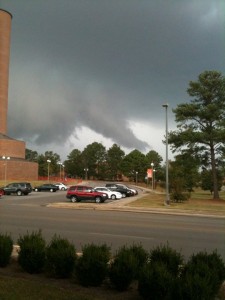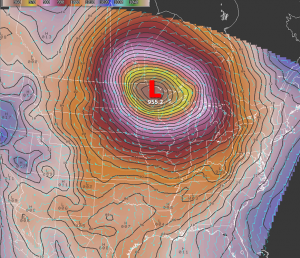28 October 2010
The Gales of November Came Early
Posted by Dan Satterfield

Devin Bowling took this picture of a wall cloud in Albertville, Alabama Tuesday. What looks like a tornado is actually a "tail" cloud. Sometimes called a "beavers tail".
As forecasters expected, violent storms tracked across Alabama and Tennessee on Tuesday. Tornadoes then hit South Carolina in the early morning hours of Wednesday. I was on air for nearly 8 hours straight. My voice is yet to recover.
Wall clouds are the parent clouds of a tornado. Not every wall cloud will produce a twister but if you see one, go the other way. Fast. Better yet, get under something sturdy. DO NOT head for a nearby overpass. Winds are accelerated under them and taking shelter under one can be a deadly mistake.
On the Great Lakes, it was the second strongest storm on record. Winds gusted to 80 mph. The waves on Lake Superior reached 9 meters!! (For the metrically challenged that’s over 26 feet!!)
The pressure at the center of the storm dropped to 955.2 millibars. That’s the lowest pressure ever recorded in Minnesota. Only the storm of January 1978 was stronger.
The 1978 storm is referred to as the great Ohio Blizzard. The pressure dropped to an incredible 950 millibars in that storm. Almost everyone older than 35 in Ohio can tell you stories of that event.
The storm in 5th place is rather famous. On November 10, 1975, (thirty-five years ago next month) a surprise storm produced a low pressure of 980 millibars. That storm hit Lake Superior hard and resulted in the sinking of an iron ore carrier called the Edmund Fitzgerald.
Canadian singer Gordon Lightfoot made the gale famous by his song about the doomed freighter. One part of the song goes like this:
With a load of iron ore – 26,000 tons more
Than the Edmund Fitzgerald weighed empty
That good ship and true was a bone to be chewed
When the gales of November came early
One line in particular has stayed with me.
“Does anyone know where the love of God goes, when the waves turn the minutes to hours.”
Update Oct. 29,2010: It now appears that the Minnesota storm missed the non tropical storm record for the mainland U.S. by 0.01 inches of mercury!



 Dan Satterfield has worked as an on air meteorologist for 32 years in Oklahoma, Florida and Alabama. Forecasting weather is Dan's job, but all of Earth Science is his passion. This journal is where Dan writes about things he has too little time for on air. Dan blogs about peer-reviewed Earth science for Junior High level audiences and up.
Dan Satterfield has worked as an on air meteorologist for 32 years in Oklahoma, Florida and Alabama. Forecasting weather is Dan's job, but all of Earth Science is his passion. This journal is where Dan writes about things he has too little time for on air. Dan blogs about peer-reviewed Earth science for Junior High level audiences and up.